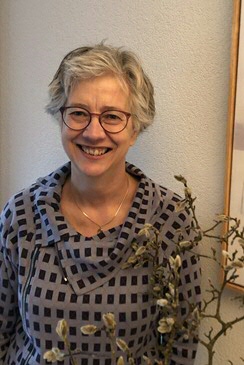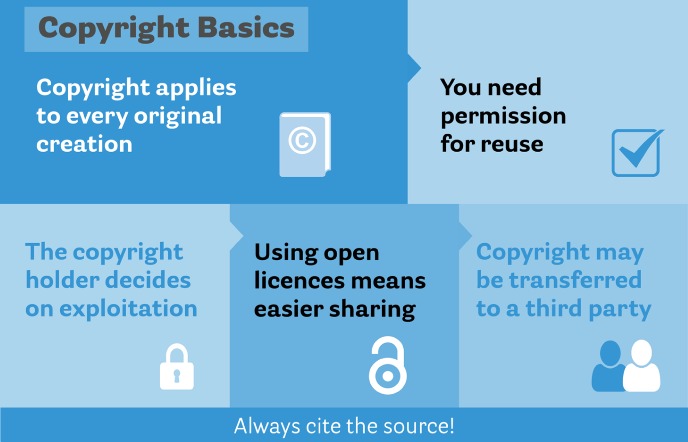Meet Dorine Kieft, copyright specialist

“What should you, as an author, consider when submitting an article for publication? How can you reuse images in your teaching? The Copyright Information Point helps with questions and provides advice and information.”
The Copyright Information Point helps researchers, lecturers, and students. Meet Dorine Kieft, academic information specialist and copyright expert at the University of Groningen Library (UB).
What is your role at the Copyright Information Point?
I answer questions we receive and provide advice and information. For example, a colleague and I recently gave a workshop upon request at a UG faculty on the reuse of copyright-protected material in education, how to create reliable, permanent links to a journal, article or e-book, and how to find open educational resources. Lecturers were also able to ask questions.
I also maintain national contacts, for example through the Netwerk Auteursrechten Informatiepunten (Copyright Information Network), a national network for university education. I am chairing this network. I am also on the editorial board of the website auteursrechten.nl for higher education. Last year, I obtained a Creative Commons Certificate and I am happy to use this knowledge to benefit the university.
There are several colleagues involved in the Copyright Information Point, each contributing their own expertise; for example, experts in the field of open educational resources, open access and license management. We also work closely with the UG departments General & Legal Affairs and Educational Support and Innovation.
What do researchers and lecturers run into when it comes to copyright?
It is often unclear to researchers and lecturers where copyright lies, even in terms of their own published work. They don't always know what they can and cannot do with this.
What can I do with my own published work?
That depends:
-
If you have retained the copyright yourself, for example by publishing it open access, you can decide for yourself what you do with your work. You can distribute it without restrictions, for example via your own website or via Pure. You can use it for teaching purposes and you can modify it and make it a new publication.
-
If you have transferred the copyright to your publication to a publisher, the contract will state what you as the author are allowed to do with your publication. You will probably need permission from the publisher if you want to distribute your publication (for example via your own website or the website of a third party) or reuse it (for example, bundled with other publications).
However, your publication may become available in full text via Pure after six months. See: ‘Taverne Amendment’.The pre-print and post-print versions of your article will generally allow you to do more. On Open Policy Finder you will find information about the conditions for publishers and the rights that authors have to make an article freely accessible on their own website or in a repository.
What I also see a lot of is confusion around the reuse of images, e.g., in Brightspace, readers or lectures.
How do I reuse images (free of charge and legally) in Brightspace?
Free - What is always permitted?
There are a few ways to include images in Brightspace without infringing copyright or incurring additional costs.
-
Using links: Using links to refer to an image in a digital resource (for which the UB has a license) is always permitted.
-
Open Content: Images published under a Creative Commons license can always be reused and uploaded to Brightspace free of charge, provided you adhere to the terms of the specific license. There are a lot of images online that are shared openly. Europeana has a large database of open-access historical art and photos. AnatomyTOOL offers open educational resources for anatomy. You can also use the Creative Commons website to search for open-access images on Pixabay and Flickr.
On this page of our Open Education LibGuide you will find several websites that host open images.
-
Quotations: Using an image as substantive support for scientific purposes is allowed. Remember to use a proper reference.This only applies if an image is a relevant addition, so no funny or entertaining pictures for decorative purposes.
Paid extracts
Easy access
Each year, the UG/UMCG pays an advance amount for materials used and for which no prior permission had to be requested. This amount is based on the size and number of extracts used in the previous year.
Easy Access: what is permitted?
You can use no more than 25 images from a publication, with no more than 10 images from the same creator.
Please note: The number of images used for the entire course are added together. For example, if you use 14 images from the same publication twice within the same course, this no longer counts as Easy Access.
For every image you are required to cite the source; see Frequently Asked Questions on how to make a proper citation.
Longer extracts?
If you want to use more than 25 images, or more than 10 images from the same creator, you must obtain the explicit prior permission of the copyright holder, for which a fee is often charged.
If you want to use a long extract from a source, the University Library can also find out whether the source is available to purchase (digitally), so that students can have access to it. Please do not hesitate to get in touch with us if you need advice or support regarding long extracts: copyright rug.nl. UMCG staff may contact auteursrecht umcg.nl.
Be critical of extracts: retain more resources for other educational matters
Wherever possible, use the free options described above. If this does not work, keep the extract as short as possible (within Easy Access, a short extract costs less than a medium extract). In this way, the RUG/UMCG retains more money for other educational matters. Read more about the RUG/UMCG's policy on the reuse of copyrighted works in education.
What I see lecturers in particular running into is lack of time to get it right with reusing materials in Brightspace or Powerpoint presentations. Hopefully, the Copyright Information Point can help with this. On our website we offer basic information and a comprehensive FAQ. Do not hesitate to contact us if you have any questions.

What advice do you have for researchers and lecturers?
1. It is a big misunderstanding that if something is freely available on the internet that you are free to use it. Our advice is to use links wherever you can, because if something is freely available on the internet, you can always refer to it. Placing hyperlinks is not considered copying or duplication and therefore does not infringe anyone’s copyrights. The prerequisite is that the information has been published legally.
Why is it preferred to link to publications in the digital learning environment?
Placing (publishing) hyperlinks is not considered copying or duplication and therefore does not infringe anyone’s copyrights. The prerequisite is that the information has been published legally.
See: How to create a reliable link.
2. If you are going to publish: negotiate! There are more ways to retain your copyright than you might think. For example, you can add a clause to your contract with your publisher so that you can use your publication for your own teaching. I have the impression that publishers are more willing to negotiate these things nowadays.
Do I have to accept the standard contract used by my publisher?
No. Signing a standard publishing agreement that transfers the entire copyright to the publisher is not always necessary, nor is it to your advantage. A contract represents an agreement between two parties. Publishers will usually have a standard contract for publishing material but that does not mean that it cannot be changed. Be clear about what you want and ask your publisher to include it in the contract. It is often a matter of negotiation but you are certainly not obliged to sign a standard agreement just like that.
Negotiate!
The standard contract used by your publisher is not binding as long as you do not sign it. Amendments can be made if you resist pressure from the publisher and communicate with them. You can negotiate the terms of the contract. Ask yourself: is this an exclusive license? Can the license be terminated?
Before and after negotiation
The most effective technique is to delete unwanted terms and write and initialize the changes you want.
The Dutch universities, in collaboration with SURF, have prepared an example of a License to Publish that you can use as a template.
3. Do you have questions about copyright ? Please contact us at copyright rug.nl, and for UMCG staff at auteursrecht umcg.nl.
More information
Contact
-
copyright rug.nl
-
auteursrecht umcg.nl
| Last modified: | 11 February 2025 4.04 p.m. |

